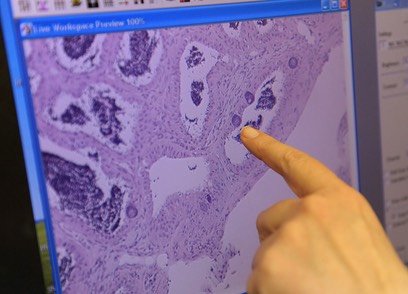As more male bass switch sex, a strange fish story expands

Previous studies showed a high level of chemicals from animal farms and human waste at smallmouth bass nesting areas in the Potomac River. (Ricky Carioti/The Washington Post)
By Darryl Fears August 3, 2014
At first she was surprised. Then she was disturbed. Now she’s a little alarmed. Each time a different batch of male fish with eggs in their testes shows up in the Chesapeake Bay watershed, Vicki Blazer’s eyebrows arch a bit higher.
In the latest study, smallmouth bass and white sucker fish captured at 16 sites in the Delaware, Ohio and Susquehanna rivers in Pennsylvania had crossed over into a category called intersex, an organism with two genders.
“I did not expect to find it quite as widespread,” said Blazer, a U.S. Geological Survey biologist who studies fish. Since 2003, USGS scientists have discovered male smallmouth and largemouth bass with immature eggs in several areas of the Potomac River, including near the Blue Plains Advanced Wastewater Treatment Plant in the District.
The previous studies detected abnormal levels of compounds from chemicals such as herbicides and veterinary pharmaceuticals from farms, and from sewage system overflows near smallmouth-bass nesting areas in the Potomac.
Those endocrine-disrupting chemicals throw off functions that regulate hormones and the reproductive system. In the newest findings, at one polluted site in the Susquehanna near Hershey, Pa., 100 percent of male smallmouth bass that were sampled had eggs, Blazer said.

A magnification of a cross-section view of a smallmouth bass' testes that shows immature eggs, which are round circles on the monitor. (Ricky Carioti/The Washington Post)
With the mutant bass, she said, “we keep seeing . . . a correlation with the percent of agriculture in the watershed where we conduct a study.”
The fish that were dissected and analyzed by researchers swam downstream from farms and animal feed operations, where rains wash manure filled with various chemicals and hormones into streams and rivers.
It was a familiar finding. After the first intersex bass were found in the Potomac, the U.S. Fish and Wildlife Service made a remarkable discovery in follow-up research at Blue Plains: “We found female germ cells in the testes of 82 percent to 100 percent of the male smallmouth bass and in 23 percent of the males from . . . largemouth bass,” the agency said.
It is a problem that extends well beyond the Chesapeake Bay region, which includes the District, Virginia, Maryland, Delaware, West Virginia and Pennsylvania. Intersex bass were found by the USGS in the Columbia, Colorado and Mississippi river basins in 2009. Scientists have yet to identify a single chemical responsible for causing male fish to become part female.
In urban areas, estrogen products are often flushed down drains, contaminating water. In rural areas, natural animal hormones, much of it estrogen, is excreted in manure, which is spread on fields and washed into water by rain.
“I think it’s a complex mixture of chemicals,” said Blazer, who authored the study with nine researchers.
The findings published in Environmental Monitoring and Assessment coincided with a new report from the Environmental Integrity Project that says there is far more nitrogen and phosphorus pollution in the Chesapeake Bay than states and the Environmental Protection Agency have led residents to believe.
The report, “Murky Waters: More Accountability Needed for Agricultural Pollution in the Chesapeake Bay,” says monitoring of fertilizers and other chemicals used at farms, particularly large animal feed operations on Maryland’s Eastern Shore, is too lax under the bay cleanup plan that is being enforced by the EPA . . . (ahem . . .)
We at LM:GNC would like to illustrate how the Elephant in the room is so blatantly concealed by the Main Stream Media. Intersex is a well known outcome of Nuclear Contamination of living species by dispersion of Radionuclides (also referred to as a radioisotopes or radioactive isotopes; an atom with an unstable nucleus) into their environment.
. . . “Farmers should more carefully manage these manure and chemical fertilizers, and reduce them in areas where excessive amounts are being applied,” the report said. “Bay states will need better monitoring data in small sub-watersheds dominated by agriculture to accurately track pollution from farms.”
But the director of the EPA’s Chesapeake Bay Program said the report’s findings fall short because the report is based on information collected from the bay in 2009 and disregards a major event: the most aggressive bay pollution cleanup plan in history. The EPA’s so-called pollution diet started in December 2010.
The sites in the Susquehanna and Delaware rivers were studied in 2007, and the Ohio River was visited in summer the following year, Blazer said. The samples waited in a long line of items submitted for research until it was completed this year.
“It’s the way science works,” Blazer said. “It takes a long time for the chemical analysis. Labs that analyze chemicals are backed up.”
Chemical pollution in bay tributaries creates problems for smallmouth bass other than intersex fish. Catch rates of adult smallmouth bass in a stretch of the Susquehanna in Pennsylvania fell 80 percent between 2001 and 2005, according to a study by the Pennsylvania Fish and Boat Commission. Smallmouth bass in the region were pocked with sores and lesions, likely from chemicals and parasites, a report by the Chesapeake Bay Foundation said.
Researchers say they lack the data needed to pinpoint the chemicals that might cause sex changes in fish because farmers are not required to immediately report the strongest chemicals they use.
Democrats in the Maryland House and Senate sponsored a pair of bills in a legislative session last year that would have for the first time required growers to record their use of insecticides and herbicides and submit it to the state.
The pesticide-reporting rule stood to create a trove of data that scientists could draw from for studies on human and animal health, supporters said. Researchers said it would help focus research on chemical “hot spots,” the exact moment high concentrations of pesticides hit waters where vulnerable young fish are growing, Blazer said at the time of the legislation in March 2013.
But the requirement was amended after growers said the rule would be a major financial burden, and the state Department of Agriculture said it would cost $1.5 million for new employees to collect and input data. State lawmakers instead passed legislation to create a fund that would one day pay for mandatory pesticide reporting. Gov. Martin O’Malley (D) signed that legislation in May.
The fish is “an indicator that something else is really wrong,” Blazer said in support of stronger pesticide reporting. “What are these things doing to the natural environment? If we find these things in wild organisms, there’s a good chance they’re also affecting people.”
Related:
Bay’s smallmouth bass under siege, report says
Bay’s intersex fish mystery remains unsolved
Darryl Fears has worked at The Washington Post for more than a decade, mostly as a reporter on the National staff. He currently covers the environment, focusing on the Chesapeake Bay and issues affecting wildlife.
🌎
Visitors to LM:GNC








![20120724 - 7-24-2012 The More We Learn - quote from David Rockfeller -_thumb[2]](../_Media/20120724---7-24-2012-the_med_hr.jpeg)

